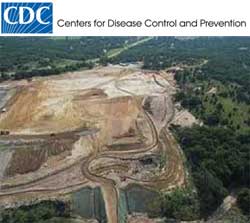
Federal health officials have issued a warning regarding the use of silica sand in the hydraulic fracturing (fracking) process. According to a Reuters report, the Centers for Disease Control and Prevention said late last week that workers at active fracking wells face a serious health hazard from overexposure to silica sand. Excessive exposure to silica […]
 Federal health officials have issued a warning regarding the use of silica sand in the hydraulic fracturing (fracking) process.
Federal health officials have issued a warning regarding the use of silica sand in the hydraulic fracturing (fracking) process.
According to a Reuters report, the Centers for Disease Control and Prevention said late last week that workers at active fracking wells face a serious health hazard from overexposure to silica sand. Excessive exposure to silica sand, a key component to employing fracking drilling for natural gas and oil, can cause silicosis, a condition marked by inflammation of lung tissue and impaired breathing.
Silica sand is used in place of several other alternative sands that do not carry the same risk to the health of workers at fracking well sites. To reach this conclusion, officials with the CDC conducted air samples from 11 fracking sites in Pennsylvania, North Dakota, Colorado, Arkansas, and Texas. At each, silica levels were above the limit considered safe by federal standards.
There are thousands of active fracking wells operating in the U.S. as drillers and natural gas companies take advantage of lax regulations and a sudden desire to find alternative energy sources to foreign-produced oil. While the boom appears to have succeeded in reducing natural gas prices temporarily, the uptick in production means more workers are employed in the industry and at risk of yet another health side effect from their work.
Fracking uses a mix of hundreds of thousands of gallons of water, sand, a drill, and a mix of more than 600 chemicals and other agents that are rushed into an underground well until they reach shale formations about two miles below the surface. The rock is blasted apart and natural gas or oil deposits are released and brought back to the surface.
There is already considerable concern among environmental advocates over the environmental dangers of fracking drilling. Many believe fracking can lead to localized water contamination, poisoning private water wells within a mile of an active well. There is also growing concern over the risks of air pollution sourced to a fracking well.
Workers at a fracking site face considerable dangers, too. Wells may be poorly constructed and employees are often poorly trained and this can lead to well blowouts and explosions. This warning from the CDC highlights dangers workers face simply from exposure to one of the key components of the drilling process. With very few regulations governing fracking drilling in place, many are operated against normal safety standards, adding to dangers faced by those closest to them.
The CDC urges well operators and workers to use protective gear to avoid exposure to silica sand and also suggests the use of alternatives to it, like bauxite, ceramic, or resin-coated sands.


